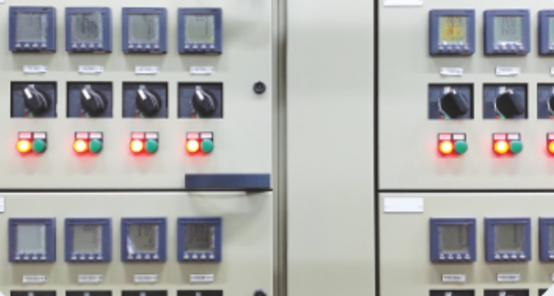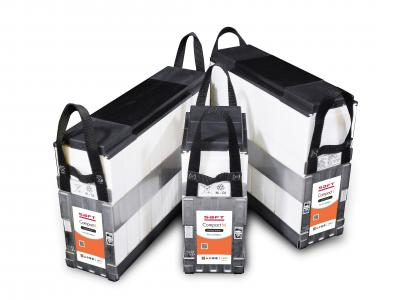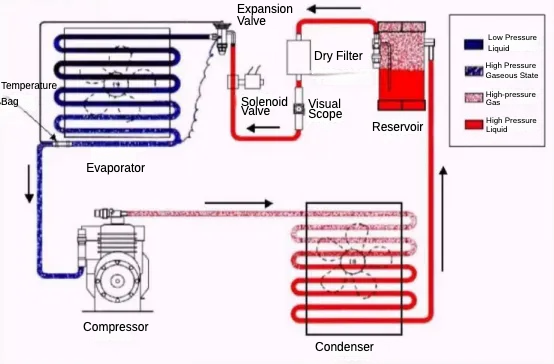The MCCB working principle is not complex. Molded Case Circuit Breakers (MCCBs), a vital component in electrical systems, use thermal and magnetic mechanisms to protect circuits from overloads, short circuits, earth faults, or other electrical faults. This article delves into MCCB construction and working to better understand the molded case circuit breaker working principle within electrical circuits.

Construction of MCCB
MCCBs are electrical switch devices with a complex internal structure that comprises the following key components:

Molded Case: MCCBs are housed in a molded plastic or thermal-resistant case. This case provides mechanical strength and insulation to the internal components.
Contacts: MCCBs have stationary and moving contacts. When the circuit breaker is closed, these contacts are in contact with each other to allow current to flow. When it’s opened, the contacts separate to interrupt the current.
Operating Mechanism: The operating mechanism is responsible for manually opening and closing the circuit breaker. It can also include a trip unit, which automatically trips the circuit breaker under certain fault conditions.
Magnetic Protection System: MCCBs are equipped with a magnetic protection mechanism to detect sudden increases in current, such as in the case of short circuits. When the current exceeds the overload threshold, the magnetic mechanism triggers the MCCB, rapidly cutting off the circuit.
Thermal Protection System: Thermal protection is another critical component of MCCBs. It operates based on prolonged overcurrent conditions. When the current remains above the rated value for an extended period, the thermal protection mechanism activates, cutting off the circuit to prevent overheating and damage.
Trip Unit: The trip unit is a crucial component in MCCBs. It consists of sensors and settings that monitor the current flowing through the circuit. When the current exceeds the preset threshold, the trip unit sends a signal to the operating mechanism to open the contacts and disconnect the circuit.
Calibration and Adjustment: Many MCCBs allow for the calibration and adjustment of their trip settings. This enables users to customize the circuit breaker’s response to different overcurrent conditions.
Arc Chutes: To quench the electric arcs that may occur during the interruption of high-current faults, arc chutes are used. These are designed to dissipate and extinguish the arc quickly to prevent sustained arcing.
Terminal Connector: The MCCB is connected to the external circuit using terminal connections. The input/supply is connected to the bottom terminals, and the output/load is connected to the upper terminals. The input and output designations are based on their physical installation, even if they are bidirectional.
Manual trip button: A button that is associated with the operating mechanism is called a manual trip button. It is mainly used to trip the breaker manually for testing purposes.
MCCB working principle from its construction
The working principle of MCCB is closely tied to its construction. Here’s how MCCBs operate based on their internal components and design:
Current Sensing: MCCBs are equipped with a current sensing mechanism, usually a bimetallic strip or an electronic sensor. This mechanism continuously monitors the current flowing through the circuit.
Calibration and Adjustment: MCCBs allow for the adjustment of their trip settings, such as the current rating at which they should trip. This makes them versatile and adaptable to various electrical systems and applications.
Thermal Overload Protection: The bimetallic strip or electronic sensor is sensitive to heat generated by the current passing through it. When the current exceeds the preset threshold for an extended period (typically for overloads), the sensing mechanism heats up.
As the bimetallic strip heats, it bends due to the differing coefficients of expansion of its two metals. This bending action activates the tripping mechanism.
The time it takes for the bimetallic strip to bend depends on the magnitude of the overload. Smaller overloads may not cause immediate tripping, but prolonged overloads will.
Magnetic Short-Circuit Protection: In addition to thermal overload protection, MCCBs offer magnetic protection for high, instantaneous overcurrent, such as short circuits.
A magnetic coil or mechanism inside the MCCB detects the rapid increase in current during a short circuit. This magnetic force causes the actuation of the tripping mechanism, rapidly opening the circuit.
Arc Quenching: MCCBs are designed with arc quenching mechanisms, such as arc chutes or arc dividers. These components help to extinguish any electric arcs that may form when the contacts open, preventing sustained arcing that could cause further damage.
If you want to check more arc flash protection products, please click here.
Tripping Mechanism: The tripping mechanism is responsible for opening the contacts when an overcurrent condition is detected. It is actuated by the thermal or magnetic sensing elements, as well as any electronic trip unit that might be present.
Manual Control: MCCBs are equipped with a manual control mechanism, typically an operating handle. Users can manually open and close the circuit breaker as needed, such as during maintenance or troubleshooting.
Status Indication: MCCBs often have indicators to show whether they are in the “on” or “off” position and whether they have tripped. This provides visual feedback about the status of the circuit protection.
MCCB working principle on different conditions

This part will introduce the MCCB working principle from 3 conditions.
Alt: MCCB working principle on normal & overload condition
Normal Operation: In normal operation, when the current is within the rated capacity of the MCCB, the circuit breaker remains closed. The current flows through the stationary and moving contacts without any issues.
Overcurrent Protection: When an overcurrent condition occurs (e.g., due to a short circuit or overload), the trip unit detects this excess current. It may use thermal and magnetic sensors to do so.
Thermal Protection: If the overcurrent persists for a longer duration, the thermal element in the trip unit heats up and causes the trip unit to actuate, opening the contacts to interrupt the circuit. This provides protection against overloads.
Magnetic Protection: For short circuits or high, instantaneous overcurrent, the magnetic element in the trip unit detects the rapid increase in current and triggers the trip mechanism to open the contacts. This provides protection against short circuits.
Earth fault protection: Protection against earth leaks differs greatly from other types of protection. That one is custom-made. Additional CT needs to be put in the circuit breaker plastic casing.
The current transformer output will be connected to the star. The neural point of the star will have zero current flow under normal circumstances. The star terminal will detect the leak if it is discovered in the line. The MCCB trips the circuit if the leakage flow exceeds the permitted limit means.
Conclusion of MCCB construction and working
According to the article, you will understand the MCCB circuit breaker working principle and the Construction of MCCB, which is essential for the design and maintenance of electrical systems. The internal construction of MCCB includes magnetic and thermal protection mechanisms, as well as a contact system. The working principle of the MCCB breaker is based on the collaborative function of these mechanisms, allowing for the rapid interruption of circuits to ensure system safety and reliability.






